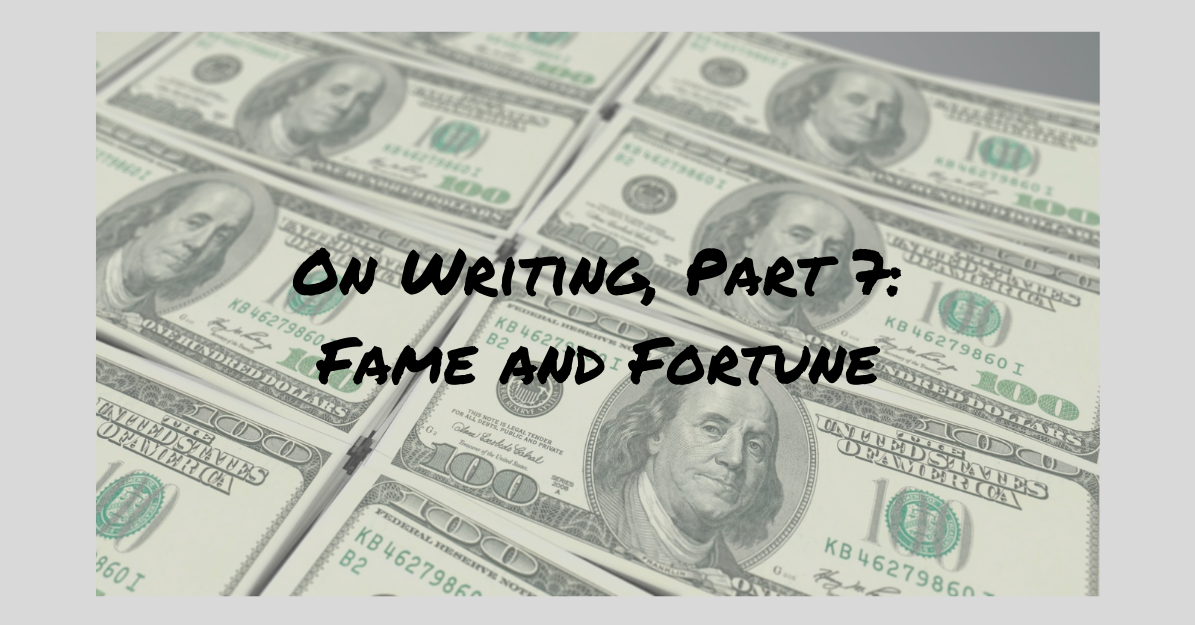Because everyone loves a good story
On Writing, 7: Fame and Fortune

In his book On Writing, author Stephen King shares the three questions he is asked most often. First is where he gets his ideas. Considering the nature of some of his work, I’d say this is a fair question, especially from neighbors.
Second is how on earth a beginning author can break into the publishing world. Now we’re onto something that interests me. And third is whether or not he writes for the money. His answer to this is, I believe, the most helpful. “I did it for the buzz. I did it for the pure joy of the thing. And if you can do it for joy, you can do it forever” (249).
What About You?
So assuming you write for the joy of the thing, you’re already off to a great start. But even those of us who write for joy still entertain hopes that we may eventually reap a paycheck from said joy, amiright? And the way to do that is to get published in some shape or fashion.
When King wrote On Writing in the year 2000, it was before the heyday of the internets and self-publishing. That’s why his advice focuses on paper submissions to paper magazines and paper book publishers. If you’re looking for advice about self-publishing your own e-book, you may not find much help here. But if you’re willing to follow the tried-and-true path that many a successful author has trod before you, then read on.
FAME: Catching a Publisher’s Attention

So how do you begin to make a name for yourself in hopes of eventually publishing a book? The key, it seems, is to start small and keep on trucking. For example, if you hope to publish a novel, perhaps you shouldn’t make that your first step. (I’m sure it can be done, but it may be harder.) Instead, start by writing short stories or articles for magazines. This requires “reading the market,” an idea that King can’t stress enough. “Submitting stories without first reading the market is like playing darts in a dark room,” says King. “You might hit the target every now and then, but you don’t deserve to” (240). Get a copy of Writer’s Market and see what each magazine is looking for. Read the magazines themselves to see what they publish. Then send them something suitable.
The bad news is that you can probably expect some rejection letters. To be honest, you can probably expect many, many rejection letters. King had a big ol’ stack of them pinned to his wall when he was starting out, and you and I probably won’t be exceptions to this rule either. But the good news is that you can send the same story to several places back to back. It’ll get noticed eventually as long as it looks professional and shows promise.
FORTUNE: …Eventually…Maybe

Now, if you hope that the first piece you sell will garner you a few grand and an honorable mention in the magazine’s year-in-review edition, you may be disheartened. If they do accept your piece, you may not be paid in anything more than cc’s—contributor copies. Or you may get a few bucks (think $20) as well as some cc’s. But the good news is that you’re not starting small to get rich; you’re starting small to accrue a list of decent sources who’ve published your stuff. Blow your earnings on a celebration meal at Taco Bell, distribute your copies as Christmas presents, and keep on writing.
King’s book tells the story of “Frank,” an aspiring author who pursues his goal of publishing a book. If this is your goal as well, you’d do well to read at least this section of King’s book. It follows Frank’s failures, triumphs, and lessons as he publishes short works in various magazines and begins writing a novel. It describes his selection of a literary agent and gives tips on what kind of letter to send in that regard. In the end, Frank is not yet a published novelist, but he is well on his way.
Frank gives hope to us all.
So Now What?
This is not actually where the book stops. King goes on to tell about how he was taking a walk one morning, minding his own business, when a van swerved off the road and accidentally hit him, nearly killing him. He has plenty to say on this subject, and if you’re interested in King’s opinion of the driver (quite negative) or of his own wife (quite positive), you can read that section for yourself. The accident was a watershed moment of sorts, but it doesn’t play into our topic here.
Instead, I hope that the takeaway from this nine-part series is a little more applicable. For example, we’ve looked at a writer’s tools, the importance of reading and writing, the parts of a good story, the various stages of your story’s drafts, tips for editing, and how to get published. If writing is your hobby, interest, or passion, there is plenty for you to chew on. And while I did present you with a good deal of his advice, there’s plenty more in King’s book.
So go read a copy of On Writing for yourself, and then keep on writing for the joy of the thing.
Source:
King, Stephen. On Writing: A Memoir of the Craft. Scribner, 2000.

Add a comment, and join the conversation!